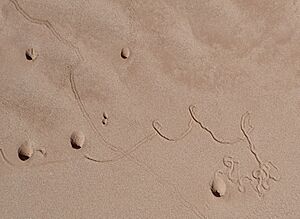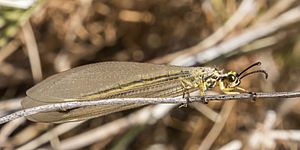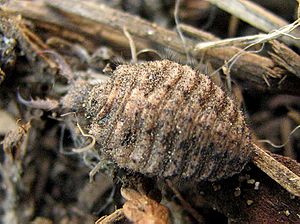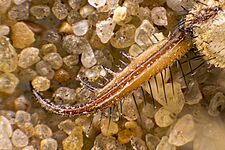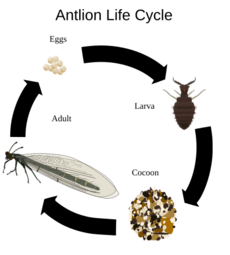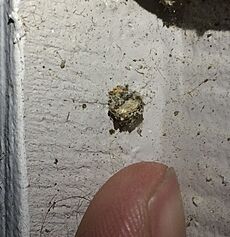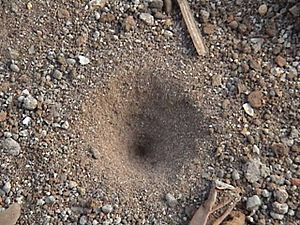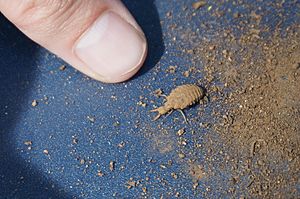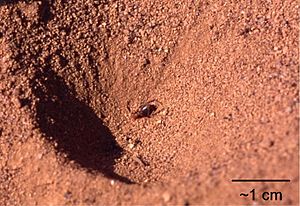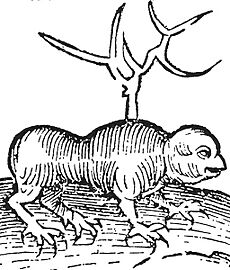Antlion facts for kids
Quick facts for kids Antlions |
|
|---|---|
 |
|
| Distoleon tetragrammicus | |
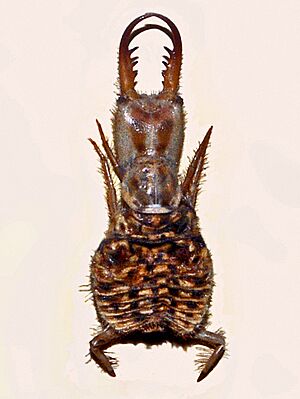 |
|
| Distoleon tetragrammicus larva | |
| Scientific classification |
|
| Unrecognized taxon (fix): | Myrmeleontiformia |
| Superfamily: | Myrmeleontoidea |
| Family: | Myrmeleontidae Latreille, 1802 |
| Subfamilies | |
|
see text |
|
Antlions are a group of about 2,000 different species of insects. They belong to a family called Myrmeleontidae. These insects are famous for how their larvae (baby antlions) hunt. Most larvae dig special pits to trap ants and other small creatures. In North America, these larvae are sometimes called doodlebugs. This is because of the wiggly marks they leave in the sand.
Adult antlions are not as well known. They live for a shorter time than the larvae. Adult antlions, sometimes called antlion lacewings, usually fly at dusk or after dark. People sometimes mistake them for dragonflies or damselflies.
Antlions live all over the world. Most types are found in warm, tropical places. But some species, like the European Euroleon nostras, live in colder areas. They often live in dry, sandy places. This is where their larvae can easily dig their traps. However, some larvae hide under leaves or other bits of nature. They wait to ambush their prey there.
Antlions do not appear often in fossils. Scientists believe antlions are closely related to owlflies. Antlions have been mentioned in books and stories for a very long time. This is because of the interesting way their larvae hunt.
Contents
What's in a Name: Antlion and Doodlebug
The exact meaning of the name "antlion" is a bit of a mystery. One idea is that it refers to ants being a big part of their diet. The "lion" part might just mean "destroyer" or "hunter." This name seems to come from ancient times.
The antlion larva is often called a "doodlebug" in North America. This is because of the strange, winding trails it leaves in the sand. These trails look like someone has been doodling.
The scientific name for the antlion family is Myrmeleontidae. This name comes from ancient Greek words. Léon (λέων) means "lion" and mýrmex (μύρμηξ) means "ant." So, the scientific name also means "antlion." In many languages around the world, these insects are known by a name that means "antlion."
Antlion Appearance and Features
Antlions are a type of neuropteran insect. They can be small or very large. Their wings can spread from about 2 to 15 centimeters (1 to 6 inches) wide. Some of the biggest antlions are found in Africa. The largest European species has an 11-centimeter (4-inch) wingspan. Many North American species are about this size.
Adult antlions have two pairs of long, thin wings. These wings have many veins and are see-through. They also have a long, slender body part called an abdomen. They look a bit like dragonflies or damselflies. However, antlions are different. They have large, club-shaped antennae that are about as long as their head and chest combined. Dragonflies and damselflies do not have these.
Also, adult antlions are not very strong fliers. They usually flutter around at night to find a mate. They are mostly active at night and are rarely seen during the day.
Male antlions often have a special knob with bristles at the base of their back wing. Their abdomen is usually longer than a female's. Female antlions have different shapes at the tip of their abdomen. This might depend on where they lay their eggs. They often have tufts of bristles for digging.
The antlion larva has a strong, plump body. It has a very fat abdomen and a chest with three pairs of walking legs. Its front body part forms a thin, movable "neck." This neck holds a large, flat head. The head has two huge, curved jaws that look like sickles. These jaws have several sharp, hollow points. The jaws are made of two parts: the maxillae and mandibles. The mandibles have a deep groove. The maxilla fits perfectly into this groove. This creates a tube for injecting venom into their prey. The venom makes the victim unable to move. Then, special enzymes help digest the victim's soft insides.
The larva is covered in bristles that point forward. These bristles help it grip the ground. This allows it to hold onto prey much bigger than itself. Antlion larvae are unusual because they do not have an anus. All the waste from their body is stored during the larval stage. Some of this waste is used to make the silk for their cocoon. The rest is released when they become a pupa.
Where Antlions Live
There are about 2,000 species of antlions around the world. Most of them live in warmer areas. Not all antlion species dig pits to trap their prey, even though these are the most famous ones. Antlions live in many dry places. These include open forests, bushy sand dunes, under hedges, along river banks, and under raised buildings. They can also be found in empty lots.
Antlion Life Cycle
Scientists have not studied the life cycle of all antlion species very much. The life cycle starts when the female antlion lays an egg. She taps the ground with her abdomen. Then, she puts her egg-laying tool into the ground and lays an egg.
Depending on the species, the larva will either hide under leaves or other natural bits. It might also hide in a crack. Or, it will dig a funnel-shaped pit in loose sand or dirt. Antlion larvae are ambush predators. This means they wait for food to come to them. Catching prey can be tricky because food does not always arrive. Also, making and keeping a trap takes a lot of energy. Because of this, larvae have slow body processes. They can live for a long time without food.
It can take several years for a larva to grow into an adult. They grow faster if they have plenty of food. But they can survive many months without eating. In colder places, they dig deeper into the ground. They stay inactive during the winter.
When the larva is fully grown, it becomes a pupa. This is when it changes into an adult. The larva makes a round cocoon out of sand or other material. It sticks the material together with fine silk. The silk comes from a thin silk-making part at the back of its body. The cocoon might be buried several centimeters deep in the sand.
The larva changes into an adult insect inside the cocoon. This takes about one month. Then, the adult antlion breaks out of the cocoon. It leaves its old pupal skin behind. It then works its way to the surface. After about twenty minutes, the adult's wings are fully open. It then flies off to find a mate.
The adult antlion is much bigger than the larva. Antlions have one of the biggest size differences between their larva and adult stages. This is because the adult's outer shell is very thin and light. Adult antlions usually live for about 25 days. Some can live as long as 45 days.
How Antlions Hunt and Live
Antlion larvae eat small insects and other arthropods. Their main food is ants. Adult antlions of some species eat pollen and nectar. Other adult antlions hunt small arthropods.
Some antlion species, like Dendroleon pantherinus, do not dig pit traps. Their larvae hide in tree holes among dead leaves and other bits. They grab prey that passes by. In Japan, Gatzara jezoensis larvae wait on rocks for several years to catch prey. They often get covered in lichen during this time.
The larva is a very hungry hunter. Within minutes of grabbing its prey, it injects venom and enzymes. Then, it starts to suck out the digested liquid parts. The larva is very sensitive to ground vibrations. These are the low sounds made by an insect crawling on the ground. The larva finds its prey by sensing these vibrations. It has special hairs on its body that act as receptors.
For species that build traps, an average-sized larva digs a pit about 5 centimeters (2 inches) deep. The pit is about 7.5 centimeters (3 inches) wide at the top. First, the antlion larva marks a circle on the ground. Then, it starts to crawl backward. It uses its abdomen like a shovel to scoop up the soil. With one front leg, it puts piles of loose dirt onto its head. Then, with a quick jerk, it throws each pile away from the pit. It slowly moves around in a circle. The pit gets deeper and deeper. The sides of the pit become very steep. They are made of fine sand that is just about to slide down. By digging in a spiral, the antlion builds its pit as fast as possible.
When the pit is ready, the larva settles at the bottom. It buries itself in the soil. Only its jaws stick out above the surface. The jaws are often wide open at the very tip of the cone. The steep pit trap guides prey into the larva's mouth. It also stops the sides from collapsing too soon. This trap is one of the simplest and best traps in the animal kingdom. The fine sand lining makes sure that any prey that falls in causes a big slide.
The sides of the pit are made of loose sand. This makes it hard for small insects, like ants, to walk on them. If an insect accidentally walks over the edge, it slips to the bottom. There, the hidden antlion quickly grabs it. If the prey tries to climb out, the larva quickly throws showers of loose sand at it. This makes the prey slide back down. By throwing sand, the larva also makes the sides of the pit collapse. This brings the prey down with the sand. So, it does not matter if the larva actually hits the prey with the sand.
Antlion larvae can catch and kill many different insects and other arthropods. They can even catch small spiders. The hollow points in the larva's jaws allow it to suck the liquids out of its victim. After the meal, the dry body of the prey is flicked out of the pit. The larva then fixes its pit. It throws out any collapsed material from the center. This makes the pit walls steep again.
Antlion larvae need loose soil, often sand. They can also handle larger bits of material. They filter these out while building their pits. The larvae like dry places that are protected from rain. When a larva first hatches, it is tiny. It hunts very small insects. As it grows, it builds bigger pits. This allows it to catch larger prey, sometimes much bigger than itself.
Other small creatures sometimes use the antlion larva's trap. The larva of the Australian horsefly (Scaptia muscula) lives in antlion pits. It eats the prey that the antlion catches. Also, a female chalcid wasp (Lasiochalcidia igiliensis) will let itself be trapped on purpose. It does this to lay its eggs on the antlion larva.
Recent studies show that antlion larvae often "play dead" when disturbed. They can do this for a few minutes up to an hour. This helps them hide from predators. This method works well. It increased their survival rates by 20%.
Antlion Evolution
The closest living relatives of antlions are the owlflies (Ascalaphidae). The Nymphidae are more distantly related. Scientists have studied the family tree of these insects using their mitochondrial DNA. It is generally agreed that antlions and their closest relatives form a single group.
Antlion Classification
Scientists have different ideas about how to group antlions into smaller categories. Michel and others recognize four main groups. These include the Brachynemurinae, Dendroleontinae, and others placed within the Myrmeleontinae.
Antlions in Stories and Games
In old stories from the southern United States, people would say a poem or chant. This was supposed to make the antlion come out of its hole. Similar customs have been found in Africa, the Caribbean, China, and Australia.
The Myrmecoleon was a mythical creature from a 2nd-century AD book called Physiologus. It was a mix of an ant and a lion. The story said it would starve to death because of its mixed nature. The lion part could only eat meat, but the ant part could only eat grain. So, the creature could not eat either and would die.
The French naturalist Jean-Henri Fabre wrote about antlions. He said, "The Ant-lion makes a slanting funnel in the sand. Its victim, the Ant, slides down the slant and is then stoned, from the bottom of the funnel, by the hunter, who turns his neck into a catapult."
Antlions appear as enemies in many video games. These include the 1991 game SimAnt, the Final Fantasy series, Grounded, Terraria, Don't Starve Together, Monster Rancher 2, Mother 3, and the Half-Life 2 series. In Half-Life 2, they are alien insects that also burrow in sand. The Trapinch, Vibrava, and Flygon Pokémon are based on antlions. The fictional sarlacc from Star Wars is often compared to real-life antlions. Antlions also appear as a predator in the movie Enemy Mine.
In the third book of Tove Jansson's Moomins series, Finn Family Moomintroll, a large and imaginary antlion appears. It is shown as a sand-dwelling predator with the head of a lion.
See also
 In Spanish: Mirmeleóntidos para niños
In Spanish: Mirmeleóntidos para niños


